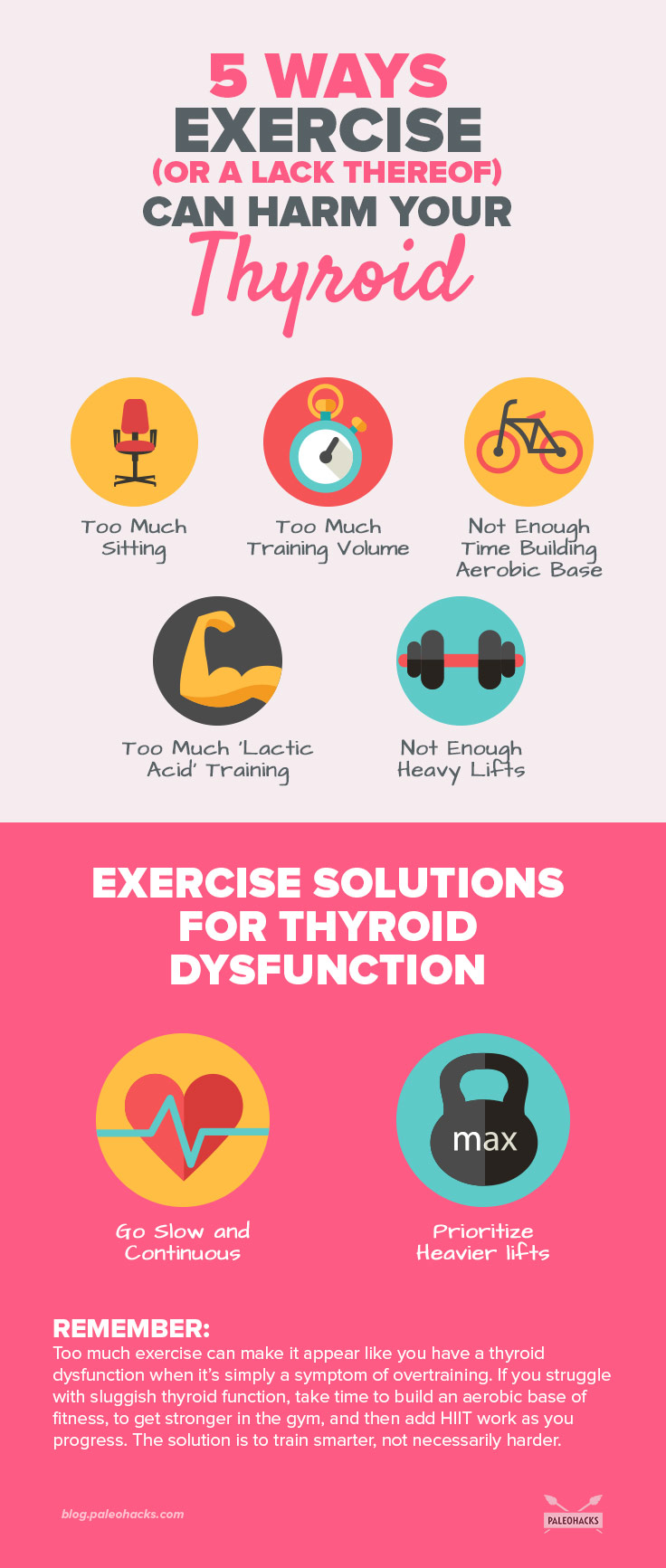Exercise is a great tool to help restore healthy thyroid function. However, like all things in nature… it’s all about finding the right dose. Overtraining can do more harm than good!
While regular movement is key to maintaining your health, too much training can apply added stress to your body and derail healthy thyroid function. These symptoms of overtraining are remarkably like thyroid dysfunction and can be seen in the lab test results of high performing athletes – both male and female – as they ramp up their training to peak for competition. Of course, athletes and coaches plan ahead and build-in “rest” and “recovery” blocks into their training to ensure they don’t overtrain. Unfortunately, this isn’t always the case for those exercising without the supervision of a certified coach or trainer.
Exercise produces a boost in cortisol stress hormones, a natural and normal response to a training stressor. However, too much training (or not enough rest) can quickly ramp up cortisol levels, which can derail healthy thyroid function. Let’s do a quick thyroid review and then look at how cortisol affects its output.
Are you struggling with a Thyroid condition? We’ve created a FREE guide that shows you how you can heal your thyroid. Click here to grab your copy!
Your thyroid gland sits at the base of your neck and impacts virtually every single cell in your body. It controls your metabolic rate and produces two key hormones – thyroxine (T4) and triiodothyronine (T3) – that travel around the body, influencing protein synthesis, vitamin uptake, sensitivity to hormones, the list goes on and on. Your brain controls the output by sending a message to your thyroid – via the TSH hormone – to ramp up or down thyroid hormone production. [tweet_quote] Your thyroid controls your metabolism — and virtually every single cell in your body.[/tweet_quote]
Chronically high cortisol levels lead to more inflammation in the body, which blunts the TSH output at the brain level as well as inhibits the conversion from T4 to the “active” T3 thyroid hormone at the tissue level.(1,2) In short, too much stress can leave your thyroid sluggish or “stuck in the mud,” and you may experience persistent symptoms of fatigue, brain fog, weight gain, low libido, low mood, cold hands and feet, etc.
Unfortunately, most people can’t nap and program in-planned recovery like an athlete. If you’re constantly busy at work and home with the stresses of day-to-day life, combined with too much training (or the wrong type), it can worsen your thyroid health rather than improve it.
Exercise Roadblocks
The following is a quick list of five different ways exercise (or a lack thereof) can derail healthy thyroid function.
Too Much Sitting
If you’re overweight or out of shape, then you’re likely not getting enough movement in your day. The average person sits eight hours per day – with some up to 13 hours – highlighting how little movement we get in our day-to-day lives.(3) This is in stark contrast to our hunter-gatherer ancestors, who moved continuously throughout the day and moved vigorously for 90-120 minutes daily.(4) The modern sedentary lifestyle – combined with the common theme of constant snacking all day – is a major underlying cause of chronically high blood sugar and insulin levels that negatively impact thyroid function.(5)
Too Much Training Volume
A common theme I see in clients who struggle with thyroid dysfunction is thinking “more is better” when it comes to exercise. They fall back on old overtraining strategies of increasing exercise (and reducing calories) to lose weight, adding more cardio days, more circuit classes, or more days in the gym to no avail. Using this approach, things often get worse for clients, not better.
[tweet_quote] More exercise isn’t always better when it comes to weight loss if you have thyroid issues.[/tweet_quote]
The real problem is lack of “efficiency” with your training. You need to train smarter, not necessarily harder. Once you adapt to a training stress, your body uses fewer and fewer calories to perform the same routine, making overtraining completely fruitless. Moreover, adding more training sessions at the same training intensity (see below for more) is the perfect storm for raising cortisol stress hormones and derailing thyroid function.
Not Enough Time Building Aerobic Base

A common theme I find amongst thyroid dysfunction sufferers is lack of patience training “slow” and properly developing an aerobic base of fitness. They lose patience and kick things up to train “the burn,” overemphasizing the lactic energy system they already likely train too frequently. It’s a recipe for overtraining and exacerbating thyroid dysfunctions.
Too Much “Lactic Acid” Training
Ironically, most people don’t spend as much time in the aerobic area, but rather jump into the lactic acid training. It kicks it when you “feel the burn” from lots of reps or your last spinning class, and most people associate this with working at their highest intensity. Not so. The lactic system can trigger a whole host of benefits, but if pushed too frequently or too hard, it can quickly lead to excessive stress on the nervous system and overtraining.(6)
[tweet_quote] Overtraining leads to more stress and cravings — totally counterproductive to a healthy lifestyle![/tweet_quote]
The trickle-down effects are increased stress and increased cravings for sweets and sugars, and often the end result is increased caloric intake (despite your best efforts to cut calories). The lactic energy system is common for overtraining, and most thyroid sufferer’s train too often and for too long without a properly periodized plan.
Not Enough Heavy Lifts
On the other end of the spectrum is the alactic system, your most powerful energy system that kicks in when you jump, lift a heavy weight 1-3 times, or sprint a short distance. This energy system is often overlooked because there is no lactic acid “burn” or “huffing and puffing,” so most clients dismiss it because it feels too easy. Big mistake.
Your “fast-twitch” muscle fibers from quick burst alactic training have the potential to trigger the greatest adaptations: in short, the quickest path to burn fat and get lean. Many people omit training this system (and muscle fiber type) for fear of getting too bulky. Ironically, it’s exactly the opposite. The strength gains you achieve in this range are neurological, so you don’t get bigger – just leaner and stronger.(7) Most thyroid dysfunction clients don’t spend enough time here.
Exercise Solutions for Thyroid Dysfunction
What’s the best way to train if you’re struggling with thyroid dysfunction? While it’s difficult to generalize a specific routine for everyone, in my experience, your best bet is to move away from moderate intensity lactic acid producing overtraining and shift your focus to the ends of the intensity spectrum: low-intensity and high-intensity training.
Go Slow and Continuous

It can also be difficult for some people – type-A personalities in particular – to train “slow” and take the time to build an aerobic base of fitness. The better your aerobic base, the more fat-burning mitochondria in your muscles, the more enzymes to breakdown fat, and the more capillaries (tiny blood vessels) innervate the muscles to expedite fat burning. In short… it’s a great way to burn more fat!
To make sure you don’t train “too hard” aerobically in the short-term, world expert Dr. Phil Maffetone has designed a unique strategy. Perform the calculation below to determine the maximum heart rate you should NOT exceed during the base building phase (4-8 weeks). Here is the equation below:
Max Training Intensity = (180 – your age)
- If you have a major illness or chronic condition, or take any regular medication, subtract an additional 10.
- If you’re injured, have hit a training plateau, get regular colds or are just getting back into training, subtract an additional 5.
- If you’ve been training consistently (at least four times per week) for two years with any problems, keep your max heart rate at 180-age.
Once you’ve done this for 4-8 weeks, start to slowly add more sprints and short, high-intensity intervals to improve fitness and lean muscle without over-taxing the stress on your body (and thyroid) with long, overtraining sessions.
In the Gym: Prioritize Heavier Lifts
Build a stronger body to reclaim your health and stay lean and trim. Start by adding more compound lifts into your regime that target multiple major muscle groups, such as: squats, deadlifts, shoulder military press, chin-ups, etc. Aim for 3 sets of 5 reps and each week reduce the number of reps and increase the repetitions (i.e., week 2: 4 sets x 4 reps). Do this for 4 weeks, then repeat (with heavier loads than the first time). Training in this manner, you’ll target fast-twitch muscle fibers that have a great capacity to change, making you leaner, fitter and stronger. If you’re not comfortable working with heavier weights, connect with a personal trainer near you or join a local CrossFit class.
The Bottom Line
Exercise is a key part of solving any thyroid dysfunction. Applied appropriately, it can help to restore energy levels and fight off weight gain. However, the wrong approach can make your thyroid condition worse (sometimes much worse!). Too much exercise can also make it appear like you have a thyroid dysfunction when, in fact, it’s simply a symptom of overtraining. If you struggle with sluggish thyroid function, take your time and build a solid aerobic base of fitness, get stronger in the gym, then sprinkle in short MetCon or HIIT work as you begin to see progress. The solution is better exercise “efficiency,” not more exercise.

(Read This Next: How to Make Your Home Thyroid-Friendly)







 What is Paleo?
What is Paleo?









Show Comments